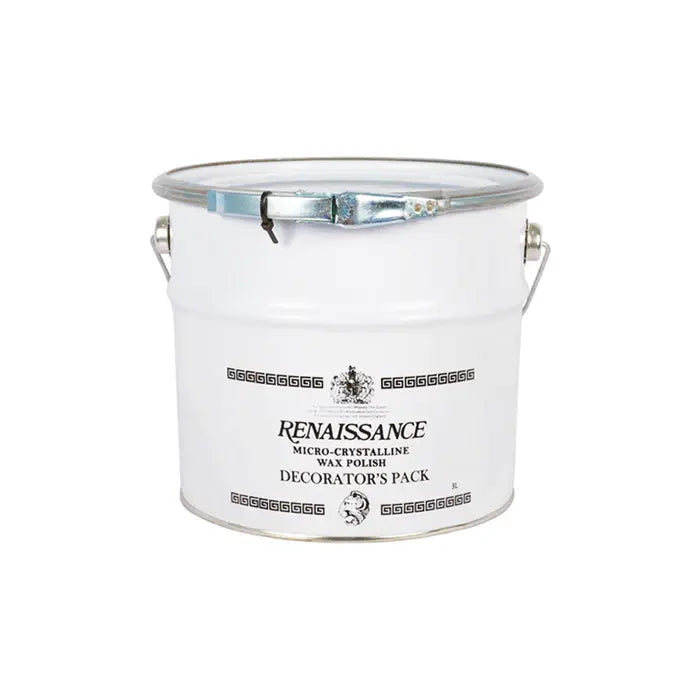Picreator Enterprises
Renaissance Wax
Renaissance Wax
13 in stock
Couldn't load pickup availability
Renaissance wax polish was originally formulated in the British Museum research laboratories in the early 1950's, in response to a discussion amongst museum technicians at an international conference on fine-art conservation.
Renaissance Micro-Crystalline Wax / Polish CLEANS BEAUTIFULLY
Lifts oil, dirt and the murky accretions of other polishes. The surface detail remains crystal clear through unlimited applications of this translucent wax.
- Removes previous wax build-up
- Reveals fine detail & wood grain
- Non-staining, non-abrasive
RESTORES AND ENHANCES
Revitalizes and returns your objects to pristine condition. Renaissance Wax buffs easily to a hard, transparent finish that will not discolor.
- Renews fading colors and “tired finishes”
- Retains matte finish when unpolished
- Buffs to a high gloss
- Reduces shine of new picture varnish
POLISHES AND PROTECTS
Guards your precious pieces against the damaging effects of humidity, heat, dust, environmental destruction, aging and ordinary wear.
Renaissance Wax provides a barrier against fingerprints and the devastation of water, wine, alcohol and other spills. Due to its high moisture resistance, it forms a durable, lustrous protective coating.
- Prevents tarnish, corrosion and “bloom”
- Remains completely waterproof
- Retards weathering on exteriors and objects exposed to climatic abrasion.
A LITTLE GOES A LONG WAY… AND LASTS A LONG TIME
Excellent spread-ability and indefinite shelf life make Renaissance Wax economical and convenient, even for very large objects and infrequent use. A small dab goes a long way, unlike most waxes that need generous application. Use a minimal amount of Renaissance Wax, rub lightly and buff.
The long-lasting preservation reduces the need for frequent maintenance.
- Airtight container keeps wax in perfect condition
- Easy to spread, no caking or drying out
- Indefinite shelf life
- No “polish” smell
- No added fragrance to endanger material
SAFE FOR ALL THESE MATERIALS:
- Wood – Raw & Finished
- Leather
- Parchment & Paper
- Metal - Silver & Silver plate, Gold, Copper & Copper Alloys, Bronze, Brass, Tin, Zinc, Nickel, Lead & Pewter, Iron & Iron Alloys, Tin & Tin Alloys
- Patinas, Enamel
- Stone - Damascus, Marble, Onyx, Limestone, Granite, Brick Clocks, Tile, Terrazzo Paintings, Obsidian, Alabaster
- Oils,Acrylics,Gouaches
- Gems
- Glass
- Porcelain
- Holloware
- Bone, Ivory, Horn, Shell & Mother-Of-Pearl, Gutta
- Gilding & Gold Leaf
- Lacquer - Japanning, Varnish, Marbleizing
- Stains & Artificial Graining
- Plastics – Formicas, Celluloid, Bakelite, Polyvinyl Acetates, Esters of Polymethyacryllic, Polycyclohexanones, Fiber Glass Epoxy Resins
USEFUL FOR THESE PRODUCTS:
- Furniture -Antique & New
- Sculpture
- Inkjet prints
- Ceramics & Pottery
- Cutlery - Knives, Swords & Armor
- Jewelry, findings, beads
- Carvings
- Antiquities
- Bibelots
- Hardware & sinks
- Wood Interiors
- Fine Books
- Clocks
- Paintings
- Carvings, Engraving,
- Scrimshaw
- Architectural Ornaments
- Dolls-antique & new
- Automobiles and Motorcycles
- Boats and Yachts
- Decoys
- Golf Clubs
- Firearms
- Frames
- Kitchen cabinets, counters, appliance s
- Musical Instruments
And Much More!
In accelerated ageing tests, the British Museum scientist found that all current commercial waxes based on the usual natural waxes (beeswax and carnauba wax) contained acids which, in time, could spoil original finishes on national historic collections of furniture. He rejected them all and investigated the new so-called 'fossil' or microcrystalline waxes being refined out of crude oil. With their distinct characteristics depending on their geographical origins, the new 'man-made' waxes could be accurately blended to meet the needs of many industries, from cosmetics and pharmaceuticals to heavy engineering. Thus, the waxes combined Nature's best qualities with the advantages of modern technology.
The blend which emerged from that research was 'designed' for long-term protection of all classes of museum exhibits. At last museum technicians and others caring for important collections could use wax polish that neither caused future conservation problems nor detracted from the intrinsic values of their treasures.
Commercial production and distribution of the polish was ultimately undertaken in 1968 by the London-based company Picreator Enterprises Ltd. under its trade name 'Renaissance'. The product was quickly accepted in the international museum world and has become a universally respected standard conservation material - probably the most widely specified - because of its almost unlimited uses.
Before waxing any metal it is important to ensure that the surface is clean so that tarnish does not spread beneath the wax. Our Vulpex technical liquid soap, which can be diluted in water or white spirit (for non-aqueous cleaning), cleans and de-greases all metals with 100% efficiency, leaving nothing potentially harmful behind. Where there is tarnish or light corrosion, our Pre-lim paste gently burnishes to a bright, scratch-free shine, ready for permanent protection by Renaissance wax.
All three products are used by professional restorers of arms and armour of historic importance.
While museum exhibits are rarely handled, brass band instruments - by the very nature of their design and purpose - are far more vulnerable to surface degradation. For the relatively modest cost of our cleaners and wax polish, owners can greatly extend the service life of their instruments - and ensure the utmost visual beauty of the metal.
Share




- Choosing a selection results in a full page refresh.
- Opens in a new window.


